Cleaning a Tesla
Last updated 08-Feb-2024
Cleaning cars for some people is a chore, while for others it is a pleasure. For us, it depends on the time of year. In winter we just want a quick and easy way to clean the worst of the dirt off the car each week without damaging the paint, In summer however, a longer clean, removing swirl marks and scratches, and applying a good coat of wax is a couple of days of relative enjoyment.
A lot of owners have ceramic coatings applied to their car, or may invest in an annual detail, so we're focusing this guide on the winter wash while causing minimal damage to the car. While "minimal damage" may sound worrying, a dirty car is covered in contaminants which if wiped with a sponge can cause fine scratches to the paint. As a result, washing the car, or even driving a dirty car in rain, can cause fine marks to the paint which build up over time resulting in the car losing it's shine.
A secondary issue when cleaning cars, especially dark coloured cars in hard water areas, is how to prevent water spots forming on the car as it dries. These are from the calcium in the water which is remained asa the waterr evaporates.
This is our guide to how we give our Tesla a quick but thorough exterior clean in winter, and how we avoid water marks on the body work. The approach can be used in summer, although make sure you're not in direct sunlight and ideally in the coolest part of the day, early moorning is best. We did this clean in about an hour, so don't bother going to the gym, give your Tesla some love.
A filthy Tesla ready for washing
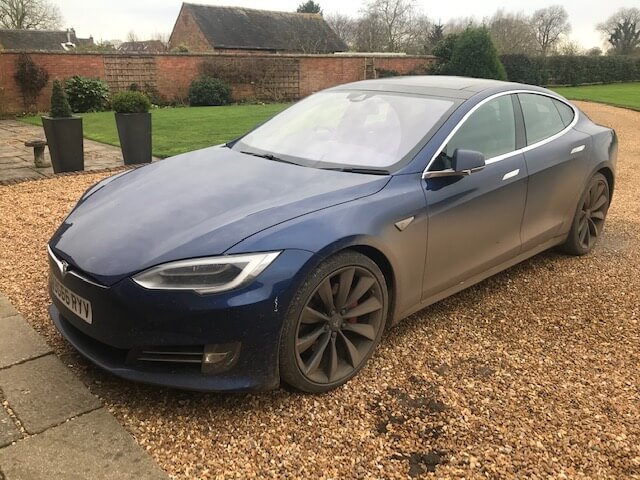
The car is absolutely filthy. I live in a rural area where I have little choice but to drive through muddy roads as farmers share them and deposit a lot of mud. We're also had some local flooding which washed the embankment onto the road. It may be hard to believe, but the car was only cleaned a week ago, this is what happens in a really short period of time in winter around here.
Snow foaming a Tesla
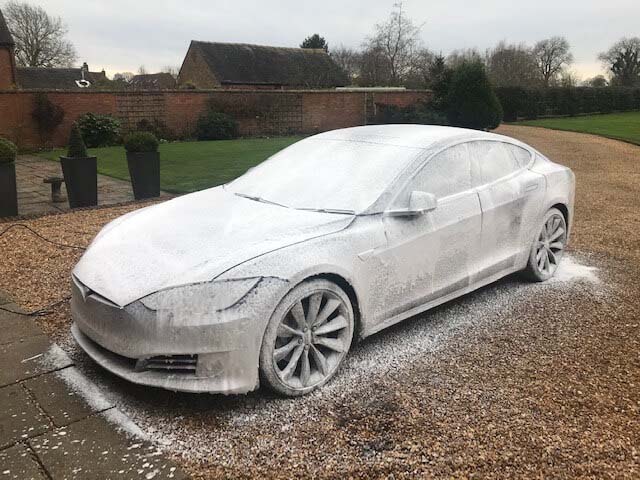
Snow foam is a great invention. It is essentially a blanket of foam that soften any dirt and lifts it away from the surface of the car. It is not perfect but it helps reduce the amount of dirt and is part of what some refer to a 'contact-less cleaning'. We recommend first giving the car a hose down using a jet wash, especially around the wheel arches and sills, to remove any bulky dirt that may have built up but to also generally wet the car allowing the foam to penetrate.
You can get dedicated Snow Foam lances which attach to a Pressure Washer which makes a good combination. Use a specialist Snow Foam detergent, mix the snow foam with warm water and simply spray onto the car and leave to dwell but not dry out.
Cleaning Tesla wheels
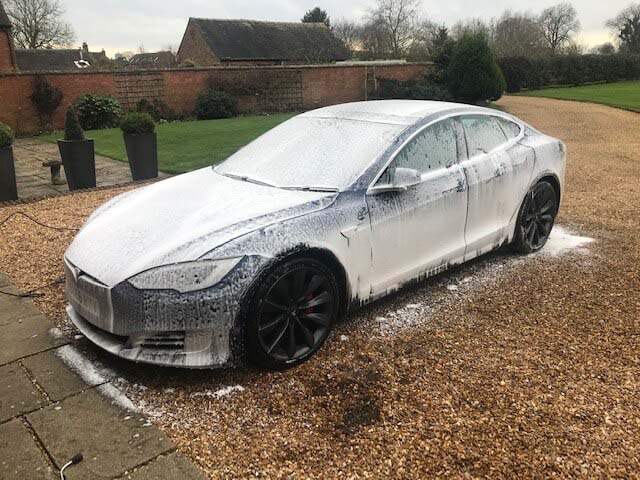
While the snow foam is doing it's thing, we give the wheels and sills a clean. Wheels are generally a horrible job but a large bucket of hot water, and the snow foam already on the wheels to act as the detergent, and a few minutes on each wheel and the job is done.
A set of Wheel cleaning brushes can also really make the job easier. Cheaper ones tend to bend, metal bits appear over time, and just don't seem to do the job. Use the largest one that fits between the spokes, do the inside of the wheel and the edges using lots of water and a cleaning mit (we have one just for the wheels) to do the spokes and outer edge. In winter it doesn't need to be perfect, but these make relatively light work of it.
First rinse
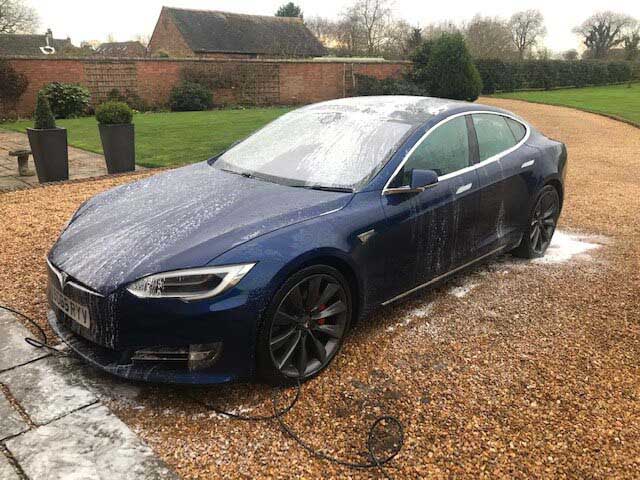
Once the wheels are done, it's time to rinse the Tesla with the jet/power wash. You don't need to be perfect with this, just focus on the lower areas of the car where the dirt is the worst. As you can see from the picture, the car is already noticeably cleaner than when we started and we're yet to touch the car with a cleaning mit.
The standard jet wash attachments don't always lend themselves well to car cleaning. We really like the Angled Spray Lance as these produce a fan of water and with the angled head allows the jet to be directed in the wheel arches, under the car, along the sides etc with ease.
Washed and rinsed
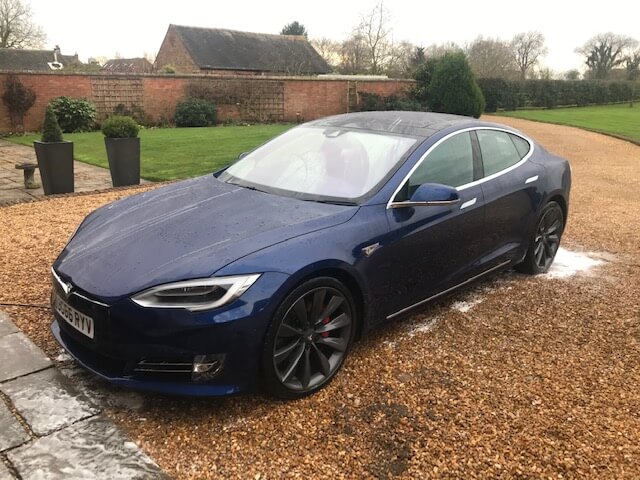
It may seem like a lot of prep before we've even touched a cleaning mit but all that effort will make this stage an absolute doddle. A fresh bucket of hot water, some fresh detergent and a different microfibre cleaning mit to the one you used on the wheels and away you go. Some like to use the two-bucket method where you rinse the cleaning mit in one bucket before loading it up with suds in the second, we find this less important if the snow foam stage has been successful, but can still help reduce the risk of scratches. As a minimum the bucket should have a grit guard that allows any grit to sink to the bottom and won't get picked up by the cleaning mit.
At this stage we'd also recommend opening the doors and wiping around the edges.
Once done, wash the car down again using the jet wash.
Drying a Tesla to avoid water marks
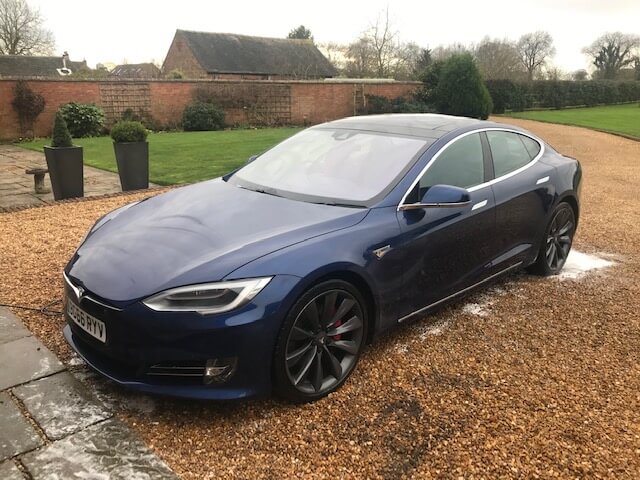
Drying a car to avoid water marks can be quite challenging, especially in hard ware areas. There are a couple of techniques, some use water filters so even if the water is left on the car, when it dries it doesn't leave a residue. Others towel dry the car by patting the car but this can be quite a slow process. Some even use a car dryer. In winter when the humidity is high and the temperature low, we find the car never seems to dry, whereas in summer it can dry so quickly you haven't had chance to remove all the water in time.
Our quick and easy tip it so use a light weight gloss enhancer. In winter where the car won't dry quickly on its own, give the car a very quick run over with a microfibre towel to remove the worst of any standing water but typically you'll find the car is still wet. Apply a liberal amount of the Extra Gloss protection to a clean microfibre towel and wipe all over the car including the glass. You will find the water is physically repelled from the car and the cloth quickly becomes very wet. Wring out the cloth, apply a bit more protection and keep going, and within only a few minutes the car will be dry but hazing over from the gloss protection.
Finally - a clean Tesla
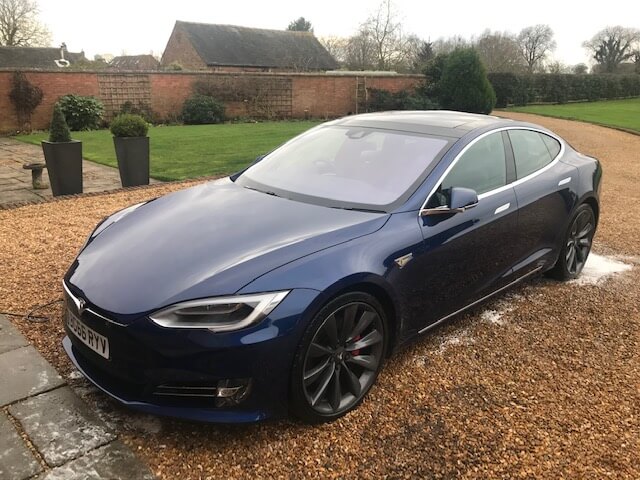
Once dry, which is only minutes, you can buff off the haze really easily with a fresh microfibre cloth. Not only do you get a great finish, you've also added a little protection to the paint work.
Variations on a theme
Avoiding water spots is a problem especially on dark coloured cars and in hard water areas. In addition to the suggestion we make above, and as touched upon you can buy water filters that reduce the impurity content in the water (look for 0 ppm water filters), these use resin. These filters require the resin replacing and can be quite expensive over time. You only need to use the water filter for the last rinse stage.
Another approach is to use a car dryer which is like a large hair dryer. Automotive ones can be quite expensive but a pet hair dryer can be just as effective and a lot cheaper. The benefits of this approach include blowing water out from behind light fittings, door handles and door mirror fixings, but it can take some time to the point that it can take so long the water has started to dry anyway leaving deposits.
Neither the water softener nor blow dry method tops up the protection on the paintwork but equally both minimise the need to touch the car which has it's own advantage.
Polishing a car
There's often confusion between waxing and polishing a car. In general, few people actually polish their car, they just wax it. There are products that are called polishers that contain microbeads and fillers that mask any light scratches by filling the small imperfections. These work well but do not last long. The advantage however is they are not destructive to the paint.
Professional or keen enthusiast polishing typically use a machine that effectively grinds the clear coat away to lower the level of the paint to remove the scratches (imagine sanding wood or metal down to remove s scratch but on a much finer scale). This results in very fine levels of removal and "grind" sounds more horrible than it is when done properly. The approach does give the best results and is long lasting, but as it is slightly destructive it is not something to be done every week.
If you are going to polish the car, then this should be done after cleaning, and ideally after additional decontamination of the paint. Using a clay bar on the paint will remove any contaminants and make the paint feel smooth to the touch. It can be quite alarming to hear the noise of a clay car over what looks like clean paint while it does its job, but is brilliant at removing invisible dirt. Once complete give the car another quick wash and rinse and then you are ready start to polishing the car either with the fillers or the machine polisher.
Following polishing you should always apply a wax or sealant to the car. Some companies sell an all in one which is fine although the results will either not be as good, or not last as long, as using dedicated products.
Wax, sealants and ceramic coating
If you want to add protection to the car then getting the car waxed with a quality wax, but be prepared to some serious elbow grease to remove it once dry. Alternatively, you can have a ceramic coating applied to your Tesla although the best version of these need to be done professionally. These activities do not need to be performed that regularly, a good wax will last 3-6 months, and the best ceramic coatings can last a number of years. Neither protect the car from actual damage from stone/rock chips etc.
You may find when washing that tar spots and other contaminates are left on the body work of the car. This can happen even when wax or a ceramic coating is present although removing them can be easier in those situations. For a quick weekly wash like the one we've described, we suggest you just leave those. When spring is in the air or you want your car to look its absolute best, then look at products such as clay bars and decontamination sprays and use these after the handwash phase, but follow them with a second handwash. If you use anything aggressive such as a clay bar, the paint must have a better protection applied at the end of the process such as a coating of wax. In which case we would advise not to dry the car with the gloss protection but to hand dry before applying the wax or sealant of your choice.
Cleaning the interior
The interior of the car is relatively easy to keep clean unless you have white seats. These quickly show up the dirt and denim colour transfer.
We find a wipe over with a specialist product works best, however All Purpose Cleaner or Baby wipes also work, they just take more effort.